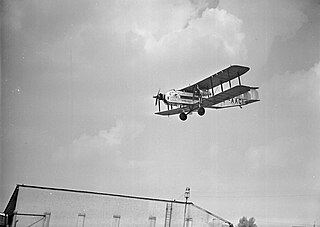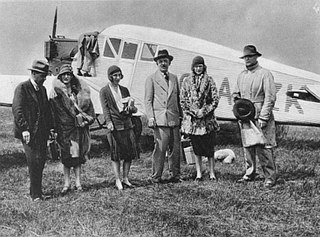
The Junkers G.38 was a large German four-engine transport aircraft that first flew in 1929. Two examples were constructed in Germany. Both aircraft flew as a commercial transport within Europe in the years leading up to World War II.

Deutsche Luft Hansa A.G. was a German airline. It served as flag carrier of the country during the later years of the Weimar Republic and throughout Nazi Germany, when it had close links to the Nazi Party.

The Junkers G 24 was a German three-engine, all-metal low-wing monoplane passenger aircraft manufactured by Junkers from 1925. Junkers F 24 was the designation for single-engine versions of the same aircraft.

The Junkers W 33 was a German 1920s single-engine low-wing monoplane transport aircraft that followed Junkers standard practice making extensive use of corrugated aluminium alloy over an aluminium alloy tube frame, that was developed from the similar but slightly smaller Junkers F 13, and evolved into the similar W 34. One example, named Bremen, was the first aircraft to complete the much more difficult east–west non-stop heavier-than-air crossing of the Atlantic.
Air Union was a French airline established on 1 January 1923, as the result of a merger between the airlines Compagnie des Messageries Aériennes and Compagnie des Grands Express Aériens. Air Union was merged with four other French airlines to become Air France on 7 October 1933.

On 28 March 1933, an Armstrong Whitworth Argosy II passenger aircraft, named City of Liverpool and operated by British airline Imperial Airways, crashed near Diksmuide, Belgium, after suffering an onboard fire; all fifteen people aboard were killed, making it the deadliest accident in the history of British civil aviation to that time. It has been suggested that this was the first airliner ever lost to sabotage, and in the immediate aftermath, suspicion centred on one passenger, Albert Voss, who seemingly jumped from the aircraft before it crashed.

The October 1926 Air Union Blériot 155 crash happened on 2 October 1926 at Leigh, Kent when Blériot 155 F-AICQ caught fire in mid-air and crashed while the pilot attempted to make an emergency landing at Penshurst Airfield. Both crew members and all five passengers were killed. This was the first in-flight fire occurring on an airliner.

The August 1926 Air Union Blériot 155 crash happened on 18 August 1926 at Hurst, Kent when Blériot 155 F-AIEB of Air Union hit a barn and crashed whilst attempting to make a forced landing in bad weather. Two passengers were killed in the accident, and the pilot died a day later.

The 1930 Air Union Farman Goliath crash occurred on 10 February 1930 when a Farman F.63 Goliath of Air Union crashed whilst attempting an emergency landing at Marden Airfield, Kent following the failure of the starboard tailplane. Two of the six people on board were killed.

The 1934 Hillman's Airways de Havilland Dragon Rapide crash occurred on 2 October 1934 when a de Havilland DH.89A Dragon Rapide of Hillman's Airways crashed into the English Channel off Folkestone, Kent, killing all seven people on board. The aircraft was operating an international scheduled passenger flight from Abridge Aerodrome to Le Bourget Airport, Paris. The accident resulted in the first write-off of a Dragon Rapide.

The 1929 Imperial Airways Handley Page W.10 crash happened on 17 June 1929 when Handley Page W.10 G-EBMT suffered an engine failure and subsequently ditched in the English Channel off Dungeness with the loss of seven lives. The aircraft was operating an international scheduled flight from Croydon to Le Bourget Airport, Paris, France.

The Meopham Air Disaster occurred on 21 July 1930 when a Junkers F.13ge flying from Le Touquet to Croydon with two crew and four passengers crashed near Meopham, Kent, with the loss of all on board. The report of the inquiry into the accident was made public, the first time in the United Kingdom that an accident report had been published.

The 1935 SABENA Savoia-Marchetti S.73 crash occurred on 10 December 1935 when Savoia-Marchetti S.73 OO-AGN of Belgian airline SABENA crashed at Tatsfield, Surrey, England, while on an international scheduled flight from Brussels Airport Haren, Belgium to Croydon Airport, United Kingdom. All eleven passengers and crew were killed.

The 1933 Imperial Airways Ruysselede crash occurred on 30 December 1933 when an Imperial Airways Avro Ten collided with one of the radio masts of Belradio at Ruysselede, West Flanders, Belgium and crashed killing all ten people on board. The aircraft was operating an international scheduled passenger flight from Cologne, Germany to London, England via Brussels, Belgium.

The August 1923 Air Union Farman Goliath crash occurred on 27 August 1923 when a Farman F.60 Goliath of Air Union crashed at East Malling, Kent, United Kingdom following an engine failure and reported panic amongst the passengers. One person was killed and nine were injured, including celebrated French actor Jean Murat.

The 1923 Daimler Airway de Havilland DH.34 crash occurred on 14 September 1923 when a de Havilland DH.34 of Daimler Airway operating a scheduled domestic passenger flight from Croydon to Manchester crashed at Ivinghoe, Buckinghamshire, England, killing all five people on board.

The 1924 Imperial Airways de Havilland DH.34 crash occurred on 24 December 1924 when de Havilland DH.34 G-EBBX of Imperial Airways crashed at Purley, Surrey, United Kingdom killing all eight people on board. The aircraft was operating a scheduled international flight from Croydon, Surrey, to Paris, France. It was the first fatal accident suffered by Imperial Airways and led to the first public inquiry into a civil aviation accident in the United Kingdom. As a result of issues brought up during the inquiry, Croydon Airport was expanded, absorbing most of Beddington Aerodrome.

Prince Eugen of Schaumburg-Lippe full German name: Wilhelm Eugen Georg Friedrich August Albrecht zu Schaumburg-Lippe was a son of Prince Maximilian August Jaroslav Adalbert Hermann of Schaumburg-Lippe (1871–1904) and Princess Olga Alexandra Marie of Württemberg (1876–1932). Prince Eugen was second pilot on a Luft Hansa air liner flying from Croydon to Amsterdam














